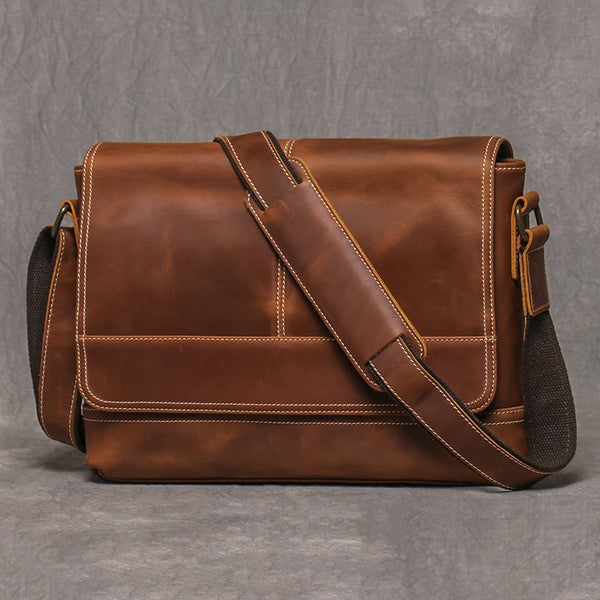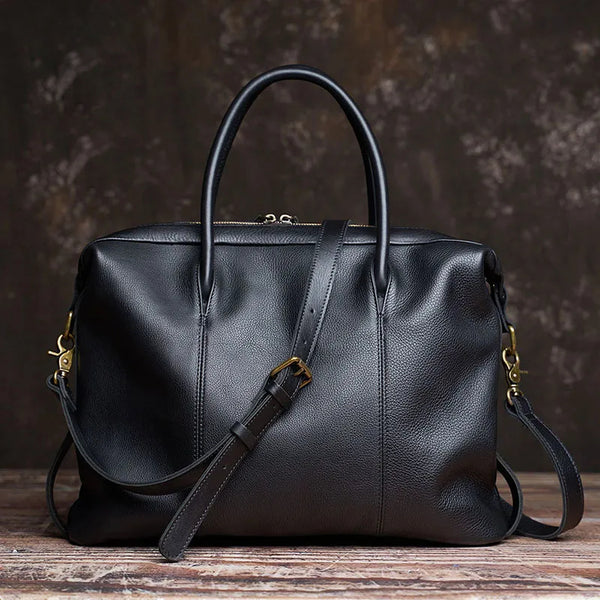What is the difference between leather and leather?
Differences between leather and leather: Comparison based on price, quality and durability
In this article, we will explain in detail the difference between leather and leather. We will start with the definition of leather and leather and the difference in manufacturing processes, and also touch on differences in quality, durability and price. We will also explain how to use and maintain leather and leather.
Related Products
Crazy Horse Leather Shoulder Bag_Y
A 100% genuine cowhide crazy horse leather shoulder bag that will add a stylish touch to your day. You can be a reliable partner for any occasion, from business to relaxing weekends to travel. The texture deepens with each ageing, and grows along with your individuality. The ultimate choice to complete a high-quality everyday life with this one.

table of contents
- 1. Definitions and basic differences between leather and leather
- 2. Differences in the manufacturing process of leather and leather
- 3. Differences in quality and durability between leather and leather
- 4. The difference in price between leather and leather
- 5. The difference between how leather and leather is used and how to maintain it
- 6. Summary
1. Definitions and basic differences between leather and leather
Leather and Hide are both materials made from animal skin, but there are significant differences in their definition, processing processes and uses. Understanding this difference is important when choosing the material.
Leather definition:Leather refers to materials that have been processed through a specific chemical treatment to improve the durability, flexibility and aesthetic appearance of animals. A process commonly known as tanning protects the raw skin from moisture and decay, transforming it into a material that can withstand long-term use. A variety of chemicals are used for tanning, including vegetable tannins, machetes, and aldehydes. Through this processing, leather is transformed into a high-quality material used in a wide range of products, including clothing, shoes, bags, and furniture.
Definition of skin:On the other hand, skin refers to materials that have an animal's skin as is or have been treated with minimal processing. The skin is mainly made from dried raw skin that peels off after the animal is slaughtered, and since there is less processing process than leather, the original characteristics and texture of the material are preserved. However, it cannot be expected to be as durable or flexible as leather. Leather is mainly used for specific purposes, such as ornaments and some clothing.
The most fundamental difference between leather and leather is in the presence or absence of a processing process. Leather is subjected to complex chemical treatments to enhance durability and wear. This allows the leather to remain beautiful and functional for a long time. On the other hand, the skin retains its natural state, allowing you to enjoy its raw texture, but it has the characteristic that it easily deteriorates over time.
Thus, although leather and leather originate from the same animal skin, there are significant differences in processing methods and ultimate uses. As a consumer, it is important to understand these differences and choose the material that best suits your needs.
2. Differences in the manufacturing process of leather and leather
Leather and leather are both materials manufactured from animal skin, but there are significant differences in their manufacturing process. These differences directly affect the quality, durability, application and price of the final product.
Leather manufacturing process
The leather manufacturing process is precise and complex, and is completed in many stages. Below are the main steps:
- Preparation of raw skin:It starts by cleaning raw skin obtained from livestock and salting it for storage.
- Pre-processing:Soak the salted skin in water to wash off the salt, remove hair and remove any unnecessary areas of the skin.
- Tanning:One of the most important steps is the chemical treatment that converts the leather into leather. At this stage, the skin is treated with chemicals such as vegetable tannins and maustenates to provide flexibility and durability.
- Finishing:After tanning, the leather is customized to suit a variety of uses, through finishing processes such as coloring, polishing and waterproofing.
Skin manufacturing process
On the other hand, the manufacturing process for leather is not as complicated as leather. The main steps are as follows:
- Collecting raw skin:Just like leather, livestock skin is used as a raw material.
- Drying:After cleaning the raw skin, let it dry naturally. This process uses no chemicals and preserves the natural properties of the skin.
- Minimum processing:If necessary, the skin may be subjected to minimal physical treatment, but it is basically used while maintaining the condition of the raw skin.
Thus, there are significant differences in the technology used, processing complexity, and time and cost in the leather and leather manufacturing process. Due to its advanced processing, leather is highly durable and suitable for a variety of designs and applications. On the other hand, leather remains more natural and offers a distinctive texture and warmth, but is not as processed as leather.
3. Differences in quality and durability between leather and leather
The difference between leather and leather is not only evident in its appearance, but also in its quality and durability. These properties arise directly from differences in manufacturing processes and are important factors in product selection and use.
Leather quality and durability
Leather achieves high durability and quality through multiple treatments and finishing processes that take place during its manufacturing process. The tanning process reinforces the leather fibers and transforms it into a material that is resistant to water and dirt. Additionally, additional finishing processes such as dyeing and waterproofing ensure that the leather remains beautiful for a long time while being strong enough to withstand strict conditions of use in daily life. With proper care and maintenance, leather products can be used for decades.
Skin quality and durability
On the other hand, leather is less durable than leather because it has not undergone the same processing as leather. The skin is soft and feels good to the touch because it remains natural, but it easily deteriorates over time, and is especially susceptible to damage from water and direct sunlight. In addition, leather products are more difficult to maintain than leather products, and if humidity is insufficient, they are more likely to develop mold and cracks due to dryness.
Thus, the difference in quality and durability between leather and leather is directly related to the unique properties of each material. The leather is reinforced through processing, making it durable enough to withstand long-term use. In contrast, the leather retains a more natural form and offers a distinctive texture and warmth, but cannot be expected to be as strong or durable as leather. Therefore, when choosing a product, it is important to choose the right material, taking into consideration the application, durability you expect, and ease of maintenance.
4. The difference in price between leather and leather
There is a noticeable difference between leather and leather not only in the manufacturing process, quality and durability, but also in the price. This price difference is due to differences in the time, effort involved in processing the materials, and the chemicals and technology used.
Leather price
Leather products are generally expensive. This is because the leather manufacturing process is complicated and time-consuming and costly. Tanning and finishing processes require special chemicals and advanced techniques, and the skills of skilled craftsmen are essential to perform these processing. Additionally, high-quality leather products are highly durable and can be used for a long period of time, which tends to be expensive as an initial investment. Furthermore, high-grade leather, which is produced only from the skins of certain animals, is also priced high due to its rarity.
Leather price
On the other hand, leather products are generally cheaper than leather products. The skin is processed to a minimum, which keeps the manufacturing process relatively low. Furthermore, leather products are not as durable as leather products to withstand long-term use, so their value is often underrated. However, leather products are highly regarded in certain markets and applications because they allow you to enjoy their natural texture and unique texture.
The price difference between leather and leather is justified by the product's lifespan, the labor involved in manufacturing, and the differences in aesthetic and functionality offered by the product. By taking these factors into consideration when choosing a product, consumers can choose the best material that suits their needs and budget.
5. The difference between how leather and leather is used and how to maintain it
Due to differences in their characteristics and durability, different approaches to use and maintenance are required. Understanding these differences is important to extend the lifespan of your product and enjoy maximum value.
How to use and maintain leather
Leather products are used in a wide range of applications due to their durability and luxury. Leather is used in a variety of items, including clothing, shoes, bags, wallets, and furniture. Regular cleaning and moisturizing are essential for maintaining leather products. After wiping off dirt on the surface with a commercially available leather cleaner, it is then moisturizing with leather conditioner to keep the leather flexible and prevent cracking. Leather products must also be protected from direct sunlight, extreme temperatures and humidity. With proper maintenance, leather products can remain beautiful and functional for many years.
How to use and maintain skin
Leather products are used in clothing, decorations, and some accessories due to their natural texture and softness. The leather is not as processed as leather, so it is sensitive to water and friction, and requires more care when maintaining it. Light moisturizing is recommended for maintenance of leather products to prevent dryness, but excessive moisture should be avoided. It is also important to gently wipe off leather products with a dry cloth after use and store them in a breathable place. Although leather products are not as frequently required as leather products, they require gentle care that takes into account their delicateness.
Understanding the difference between using and maintaining leather and leather is essential to properly treating products manufactured from these materials and enjoying their value over the long term. Leather products are suitable for everyday use due to their durability and ease of maintenance, and with proper care, they can remain beautiful for a long time. On the other hand, leather products offer their natural beauty and distinctive texture, but their delicateness requires more careful handling.
6. Summary
In this article, we have explained in detail the definition of leather and leather, manufacturing processes, quality and durability, price, and differences in usage and maintenance. These materials are often confused because of their similar appearance, but there are significant differences in their properties, uses and value.
Leather is a high-quality material that has improved durability and flexibility through a detailed manufacturing process. This allows leather products to be used for a long period of time and can further extend their lifespan with proper maintenance. On the other hand, leather is treated to a minimum and you can enjoy its natural texture and texture, but it is not as durable as leather.
In terms of price, leather products are in high price range due to their processing processes and durability, but considering long-term use, the investment value is extremely high. Leather products are relatively affordable and suitable for those looking for a unique texture, but care must be taken when it comes to maintenance and usage environments.
Ultimately, the choice of leather and leather depends heavily on the purpose of use, budget, willingness to maintain, and personal preferences. We hope this article has provided useful information to help you understand the differences between leather and leather and select the material that is best for you. Both materials can be maintained in good condition and maintainable for years to maintain their beauty and functionality.
Choose the material that suits your lifestyle and make the most of the unique beauty and functionality it has.
Related Products
Genuine leather tote bag_A
A sophisticated invitation to everyday life - 100% genuine cowhide oil leather tote bag. For business and private life, this is just one thing. The design combines soft texture with rich functionality to create a high-quality presence in your everyday life. This accessory combines the ultimate style and functionality for adults who know the authenticity.

Genuine leather business bag_A
This bag is made from luxurious full-grain leather, and has a canvas lining inside. Therefore, it combines luxury and durability, making it a great choice for a long time.

You can see COWMONO leather products, which offer high quality at low prices, below.
Crazy Horse Leather Products available here
Genuine leather products can be found here
Author information

Author: Yama (Cowmono Owner)
Occupation: Slowth lab Representative
Self-introduction: Worked in sales and marketing for domestic and international apparel companies over quarterly. He has a deep knowledge of fashion, sports, outdoor activities, and subculture.